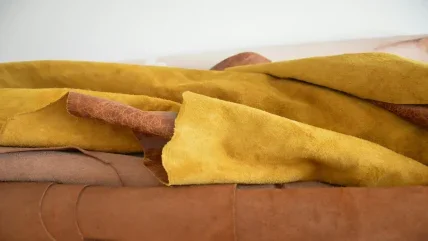
One way of overcoming this roughness is to heavily emboss a pattern onto the surface of the finished split leather to flatten it out or disguise it, but this can make the leather feel very firm. Also, because a split leather does not have a coherent surface like grain leather, when it is finished conventionally, the finish on the surface is often prone to failure as gaps form beneath the finish film as the suede fibres separate when the leather is flexed. Generally, a conventionally finished split leather is also weaker than a grain leather because the corium fibres have lost their anchorage at the base of the grain layer and are more easily pulled apart when the leather is stretched. Therefore, BLC does not recommend that conventionally finished split leather is used in areas of high wear on furniture, ie seats, arm rests, back rests etc. Bicast technology can help overcome both of these problems.
The term ‘Bicast’ is thought to come from a method of finishing known as Levercast developed by Bayer (LANXESS). It refers to a method of applying a polymer coating to a split leather. Ordinary leather is finished by spraying several coats of polymer directly onto the surface of the leather. Each coat of finish is very thin and it is built up in layers until the desired effect is achieved. In a Bicast, the polymer film is created completely separately from the leather. The process varies from one supplier to another, but basically it consists of a liquid polymer poured onto a sheet of release paper, either smooth or textured, where it forms what will be the top coat of the finish. Then a fast curing cross-linked adhesion coat is poured on which, in effect, forms the basecoat of the finish. The split leather is then applied to the still wet finish coat and cured. As the finish film is created independently of the leather, any unlevelness is not replicated in the finish with the adhesive layer tending to fill in any deep holes in the surface. Therefore, it is a good method for producing an even-surfaced leather from what would otherwise be a generally poor quality rough piece. Finally, the release paper is removed and can be re-used several times.
How does it perform?
BLC has tested many Bicast products intended for use in furniture and found that the tear strength of Bicast is usually superior to that of a conventionally finished split leather because the thicker finish film imparts some degree of strength. This feature has enabled Bicast to be used successfully in stress areas of furniture eg, the seats and back rest, where a conventionally finished split would often fail.
Our tests have found that some Bicasts fail to meet the requirement for flex endurance. In particular, we have found that the ones that have a foamed finish coat are more prone to failure than those with a solid coat (Figures 2, 3). It would appear that where bubbles are close to the surface, they are prone to splitting open when the finish film is flexed and stretched.
It has also been observed in our laboratory that, when tested for resistance to soiling, the finish sometimes swells and softens slightly when oil is applied to the surface. Interestingly, one of the most common consumer complaints we receive on Bicast products is the finish going sticky where the head and hands touch. When viewed in the cross-section, the finish has almost ‘melted’ (Figures 4, 5). The finish can be adversely affected and de-stabilised by oils, either those applied in the form of ‘leather conditioning’ products or those from the skin.
Is it leather?
Bicast products have a much thicker finish film on the surface than a conventionally finished split would have. According to the British Standard BS 2780, Glossary of Leather Terms, real leather should not have a surface coating of more than 0.15mm thick. If the finish does exceed 0.15mm, it should be described as a ‘coated leather’. We have found that many Bicast products exceed this requirement, with some having a coating as thick as 0.4mm (Figures 6, 7). These should not be described as leather as, in the eyes of a Trading Standards Officer, they would be mis-described if they were.






